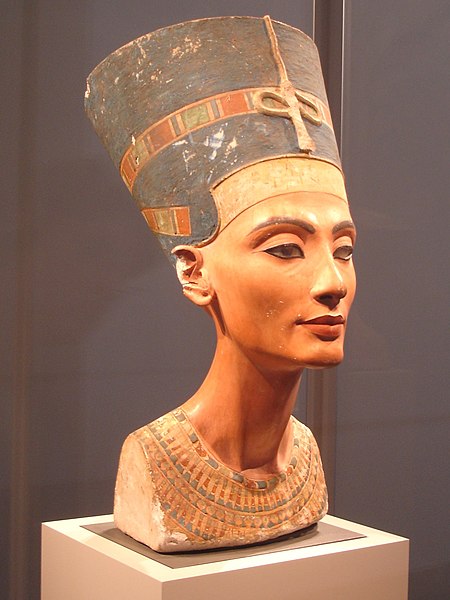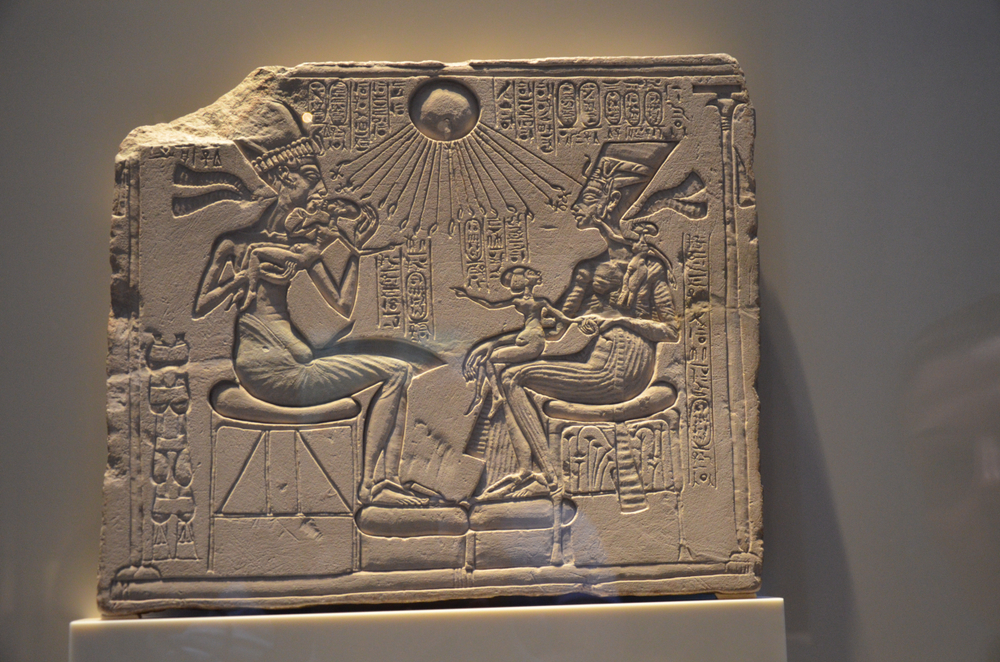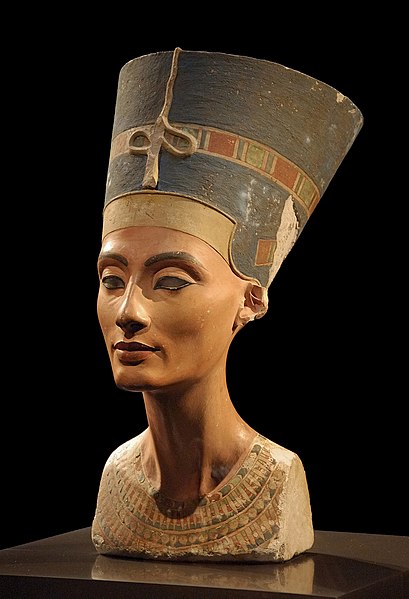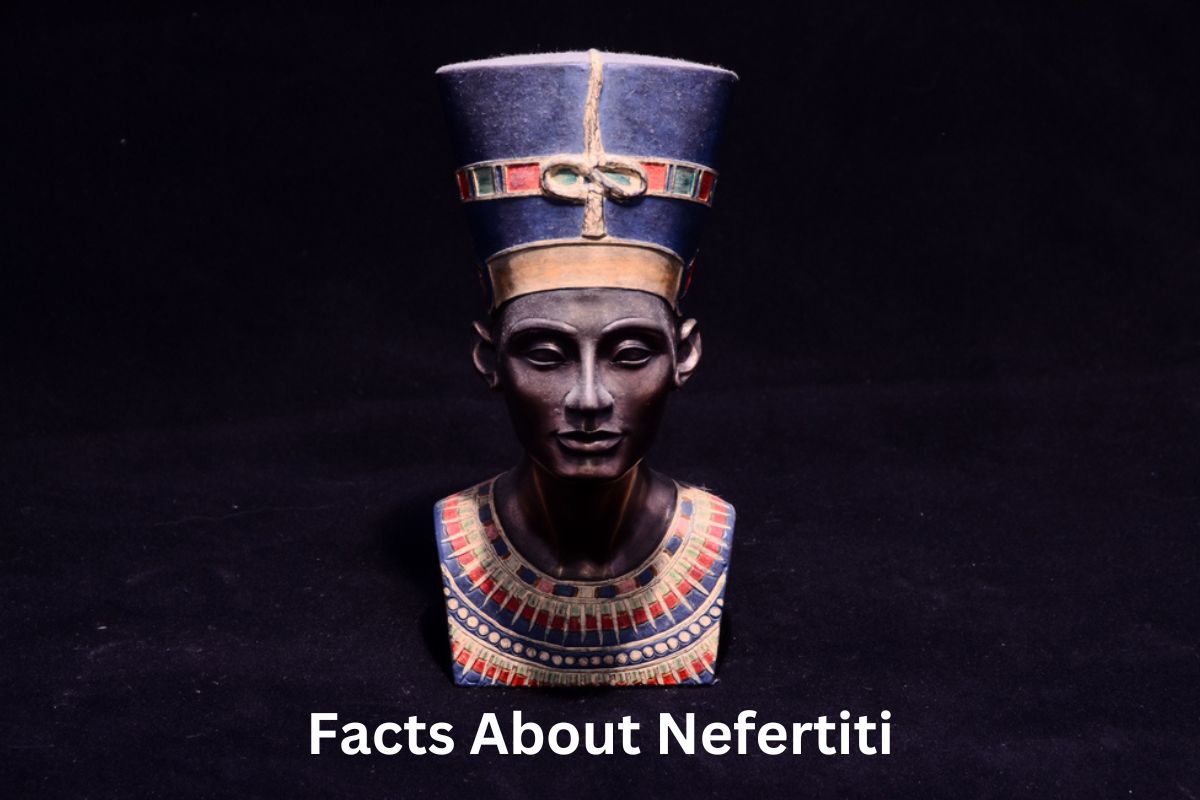Nefertiti was an Egyptian queen who lived during the 14th century BCE. She was the Great Royal Wife of Pharaoh Akhenaten, known for her exceptional beauty and influence. Nefertiti played a significant role in her husband’s religious revolution, promoting the worship of the sun disk deity, Aten.
She held significant power and often appeared alongside Akhenaten in official ceremonies and religious rituals. Nefertiti is famous for the bust discovered in Amarna, which showcases her renowned beauty.
While her exact fate and lifespan remain uncertain, Nefertiti’s legacy as a powerful queen and symbol of beauty and female empowerment has endured throughout history.
Nefertiti Facts
1. Nefertiti was an Egyptian queen who lived during the 14th century BCE

Nefertiti was an Egyptian queen who lived during the 14th century BCE, known for her exceptional beauty and grace. Nefertiti’s name, which translates to “the beautiful one has come,” reflects the widespread admiration and fascination with her physical appearance.
Also Read: Nefertiti Accomplishments
Her striking features, such as her high cheekbones, almond-shaped eyes, and a slender neck, have captivated artists and historians for centuries. Nefertiti’s beauty was often compared to that of the ancient Egyptian goddesses, further enhancing her allure and influence.
2. Her name, Nefertiti, means “the beautiful one has come”
Her name, Nefertiti, means “the beautiful one has come.” Nefertiti’s name holds symbolic significance as it highlights her renowned beauty and the impact she made on ancient Egyptian society.
The name “Nefertiti” consists of two Egyptian words: “nefer,” meaning beautiful, and “iti,” meaning has come. The choice of this name for the queen emphasizes the awe-inspiring presence and charm she possessed.
3. Nefertiti was the Great Royal Wife of Pharaoh Akhenaten

Nefertiti was the Great Royal Wife of Pharaoh Akhenaten, who ruled during the Amarna Period of ancient Egypt. Akhenaten, previously known as Amenhotep IV, initiated a religious revolution during his reign by introducing the worship of a single deity, the sun disk Aten.
Nefertiti played a vital role in her husband’s religious reforms, standing beside him as an active participant and advocate of the new religious practices. Their partnership symbolized the unity between the royal couple and their shared vision for a new religious and artistic era in Egypt.
Nefertiti’s involvement in the Amarna Period demonstrates her influence and power within the royal court and the broader society.
4. She played a significant role in her husband’s religious revolution
She played a significant role in her husband’s religious revolution, promoting the worship of the sun disk deity, Aten, as the supreme god. Nefertiti and Akhenaten’s religious reforms were aimed at shifting the Egyptian pantheon from the traditional polytheistic beliefs to a monotheistic worship of Aten.
Nefertiti actively participated in religious ceremonies, often depicted alongside Akhenaten in temple reliefs and inscriptions. She is believed to have been an instrumental figure in promoting the new religious ideology and influencing its acceptance among the Egyptian people.
5. Nefertiti is often depicted in ancient Egyptian art with a distinctive elongated neck and a tall, blue crown
Nefertiti is often depicted in ancient Egyptian art with a distinctive elongated neck and a tall, blue crown called the “Nefertiti crown.” The elongated neck in her representations was not meant to be interpreted literally but rather symbolized her beauty and elegance.
The Nefertiti crown, also known as the “blue crown” or “cap crown,” was a unique headdress worn by Nefertiti. It consisted of a tall blue cap with a flat top and a uraeus (a stylized cobra) on the front. The crown represented her status as queen and emphasized her association with divinity.

6. It is believed that Nefertiti and Akhenaten had six daughters together
It is believed that Nefertiti and Akhenaten had six daughters together, the most famous of whom was the pharaoh Tutankhamun’s wife, Ankhesenamun. Nefertiti and Akhenaten’s daughters played significant roles in the royal family and the line of succession.
Ankhesenamun, their daughter, became a prominent figure in Egyptian history as she married her half-brother, Tutankhamun, after Akhenaten’s death.
The marital ties between Ankhesenamun and Tutankhamun served to maintain the royal lineage and consolidate power within the ruling family.
7. Nefertiti’s beauty was celebrated in many sculptures and paintings, the most famous of which is the bust of Nefertiti
Nefertiti’s beauty was celebrated in many sculptures and paintings, the most famous of which is the bust of Nefertiti, discovered in 1912 in Amarna, Egypt. The bust of Nefertiti is an iconic piece of art from ancient Egypt and is considered one of the most exquisite and well-preserved sculptures of the ancient world.
The bust portrays Nefertiti with a regal and serene expression, perfectly capturing her renowned beauty. It is believed to have been created by the court sculptor Thutmose and showcases the mastery of ancient Egyptian artistic techniques.
Today, the bust of Nefertiti is housed in the Neues Museum in Berlin, Germany, and continues to fascinate and inspire awe in visitors.
8. She held significant power and influence during her reign
She held significant power and influence during her reign, often depicted alongside Akhenaten in official ceremonies and religious rituals. Nefertiti’s role extended beyond being a queen consort.
She was actively involved in the political and religious affairs of the kingdom, and her presence alongside Akhenaten in various official events and ceremonies symbolized her authority and status.
Nefertiti’s prominent position in these public displays emphasized her partnership with the pharaoh and showcased her as a powerful and influential figure in ancient Egyptian society.
9. Nefertiti may have even briefly ruled as a co-regent with Akhenaten
Nefertiti may have even briefly ruled as a co-regent with Akhenaten, as some evidence suggests her involvement in political affairs and decision-making.
There are indications that Nefertiti held a high level of authority and may have acted as a co-regent alongside Akhenaten, particularly during the later years of his reign.
Inscriptions and reliefs depict her participating in religious ceremonies and appearing in the role of a ruling pharaoh. This suggests that Nefertiti had significant political agency and may have exercised power independently during her time as queen.
10. After Akhenaten’s death, Nefertiti’s fate remains uncertain
After Akhenaten’s death, Nefertiti’s fate remains uncertain. There are various theories about what happened to her, including the possibility that she became pharaoh herself under the name Neferneferuaten.
Some experts believe that Nefertiti outlived Akhenaten and assumed the throne, ruling for a short period before being succeeded by her son-in-law, Tutankhamun. However, concrete evidence regarding her reign as pharaoh is scarce, and the exact circumstances of her disappearance from historical records remain a mystery.
Other theories suggest that she died during childbirth, retired from public life, or adopted a different name and continued to play a role behind the scenes. The true fate of Nefertiti after Akhenaten’s death continues to be a subject of debate and speculation among Egyptologists.
11. Some experts believe that Nefertiti may have died during childbirth or at a young age
Some experts believe that Nefertiti may have died during childbirth or at a young age, while others suggest that she lived into old age. The exact date and circumstances of Nefertiti’s death remain uncertain.
Some theories propose that she died during childbirth, as there is evidence of a young woman found in the tomb of Tutankhamun who is believed to be Nefertiti. This hypothesis suggests that she may have died while giving birth to a child who did not survive.
On the other hand, some historians speculate that Nefertiti lived into old age based on a few possible references to her in later texts. However, the lack of definitive evidence makes it difficult to determine the true fate and lifespan of Nefertiti.
12. The exact location of Nefertiti’s tomb is still unknown
The exact location of Nefertiti’s tomb is still unknown, and numerous archaeological expeditions have been conducted to find her burial site.
Despite extensive efforts, Nefertiti’s final resting place has eluded discovery. Many experts believe that her tomb lies somewhere in the Valley of the Kings in Luxor, Egypt, where several pharaohs of the New Kingdom were buried.
However, no conclusive evidence has been found to confirm the location of her burial site. The search for Nefertiti’s tomb continues, fueled by the hope of uncovering more insights into her life and reign.
13. Nefertiti’s legacy extends beyond her lifetime
Nefertiti’s influence extends beyond her lifetime, as she is regarded as one of the most iconic and powerful women in ancient Egypt, a symbol of beauty, grace, and female empowerment. Nefertiti’s striking beauty and influential role as queen have made her an enduring figure in Egyptian history and popular culture.
Her bust, discovered in Amarna, has become an iconic representation of feminine beauty and has inspired countless artists, historians, and admirers. Nefertiti’s significance goes beyond her physical appearance, as she played a pivotal role in the religious and political changes of the Amarna Period.
Nefertiti’s legacy as a powerful queen and symbol of femininity has captivated the imaginations of people worldwide, making her a celebrated figure in ancient Egyptian history.
